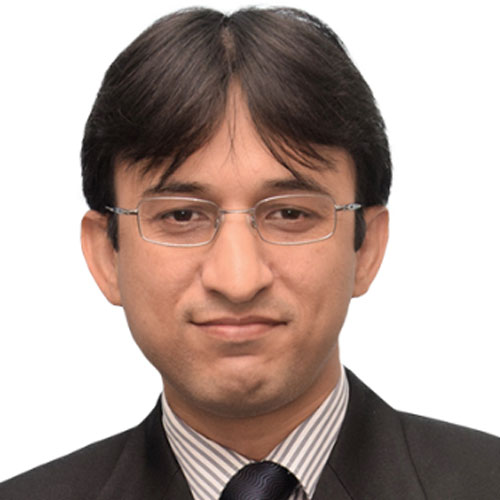Mr. Shriram Ramanathan
CIO - Fixed Income, HSBC Mutual Fund
Mr. Shriram Ramanathan oversees the management of more than Rs 30,000 cr in assets across various fixed income funds. He has over 18 years of experience in fixed income markets.
Shriram was managing the Global Emerging Market Debt (Asia) at ING Investment Management Asia Pacific in Hong Kong for about 5 years. His earlier assignments were with Zurich Asset Management Company in fixed income research and with the Treasury department of ICICI Bank, where he started his career in investments in 2000.
Mr. Ramanathan is a Chartered Financial Analyst and holds a Post Graduate Diploma in Business Management from XLRI Jamshedpur and an Engineering degree from the University of Mumbai.
1. The Fed raised interest rates by 25 bps in March, May, and July 2023. Fitch expects one more hike to 5.5%- 5.75% by September. How will this affect Indian markets? How should conservative to balanced investors react to such moves by the Fed? Suggest your views.
Since March 2022, all central banks across the world have moved out from extra accommodative policies introduced during covid and the focus has been shifted to addressing the very high inflation by increasing interest rates aggressively. In calendar year 2022 the fed raised rates by 425bps while this year they have raised rates further by 100bps to 5.25%-5.50%. The pace of rate hikes has reduced in this calendar year vs last year. In India too, the MPC (Monetary Policy Committee) increased repo rate by 250bps from 4% to 6.50%, while the overnight rates have moved up from 3.35% (reverse repo rate during Covid) to 6.50% (Repo rate now), an increase of 315bps. Increasingly the monetary policies across the world which moved in coordination since covid, both in terms of cutting rates and then raising rates, are now diverging to address the domestic growth – inflation issues. In India, the MPC and RBI may try and address the domestic inflation issues while keeping growth in mind through their policy tools.
2. The yield on the Indian 10-year government bond surged past 7.16% along with tracking the upward momentum for bond yields in the United States. On the other hand, the credit rating in the US was recently downgraded from AAA to AA+ by Fitch ratings. How can this impact bond markets in India now? Should investors consider some early warning signals? Kindly brief.
In the last 4-5 months, the US 10yr treasury yields have moved up by 100bps from a low of 3.30 to 4.30% while Indian 10yr G-Sec yields have moved up by only 20 bps from 7% to 7.20%. This has to do with the domestic orientation of the MPC and RBI, inflation broadly under control in the 1st quarter of FY 24. The bond markets in India will incrementally take cues from domestic factors like the runaway price increase in vegetable inflation lead by tomatoes and how it impacts other components in the vegetable and broadly on the food basket. The recent rise in prices of cereals and pulses as well as the impact of erratic monsoon is a cause of concern. The markets will be keenly watching the MPC reaction to this rise in inflation and the second order impact on broader inflation from this increase. Till now the MPC has decided to see through the one-off spikes in inflation caused by vegetables. On the other hand, the recent sovereign rating downgrade of US by Fitch won’t have much of an impact as dollar remains the reserve currency of the world and US is the largest economy in the world.
3. What are some medium-fiscal challenges that should be considered while investing in debt funds? Give your ideas.
In India, like in most other global economies, the central banks along with the respective governments came up with a coordinated monetary and a fiscal response to address the growth situation during Covid. While the monetary accommodation since then has been withdrawn and tightened in the last year and half, the fiscal policies in most economies are nowhere near to the pre-covid levels. The Debt to GDP ratio for all economies stands at the highest and now that interest rates have risen across economies, the incremental cost of funding this debt is posting greater challenges. While certain economies where growth is strong are well placed to address this challenge, many others are not and that will cause greater volatility both in the debt markets as well as the currencies. In India too the fiscal deficit to GDP ratio pre covid was at 3.5% while currently the target for FY 2024 is at 5.9%. However, in India, the growth is still resilient and we are one of the only major economies to grow above 6%. Also, our balance of payment position is much better bringing much stability to INR. The Government along with RBI are actively working towards bringing the spikes in food inflation under control. Considering these factors in.
4. HSBC Liquid Fund has given good returns to investors so far. What is your investment strategy behind handing this fund? Any important investment mantra you would like to give to retail investors for investing in similar or related categories of debt funds hereby?
HSBC Liquid fund has been investing in high quality well researched credits in upto 91 days maturities. It is ideal for investors to park their liquidity for shorter period. Investors can also look at funds like HSBC Ultra Short Duration Fund, HSBC Money Market Fund and HSBC Low Duration Fund with similar focus on high quality well researched credits and an investment horizon of upto 1 year.










